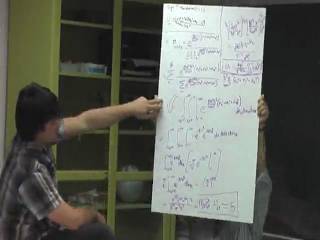You are here: start » activities » main
Calculating the Internal Energy of a Diatomic Ideal Gas
Highlights of the activity
- This small group activity is designed to help students understand how statistical mechanics is applied to concrete systems.
- Students use the vibrational, rotational, and translational energy levels of an ideal diatomic gas to predict the dependence of internal energy on temperature at either high or low temperature.
- The compare-and-contrast wrap-up addresses the process of taking low and high temperature limits, and introduces the equipartition theorem.
Reasons to spend class time on the activity
Computing the internal energy of a diatomic ideal gas provides students with an experience in the use of quantum mechanical expressions to solve a thermodynamic problem. This exercise will encourage students to think critically about what constraints limiting conditions put upon the calculation they are assigned. The computations that each small group will compute are some of the most challenging they have likely seen thus far; students will gain experience in using substitutions to pull the units from integrals and simplify their computations, and the students will also have the opportunity to practice truncating terms in an expansion expression.
